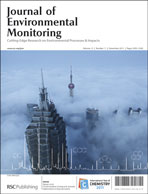To investigate the diurnal profile of the concentration and composition of ambient coarse particles, three sampling sites were set up in the Los Angeles Basin to collect coarse particulate matter (CPM) in four different time periods of the day (morning, midday, afternoon and overnight) in summer and winter. The samples were analyzed for total and water-soluble elements, inorganic ions and water-soluble organic carbon (WSOC). In summer, highest concentrations of CPM gravimetric mass, mineral and road dust, and WSOC were observed in midday and afternoon, when the prevailing onshore wind was stronger. In general, atmospheric dilution was lower in winter, contributing to the accumulation of air pollutants during stagnation conditions. Turbulences induced by traffic become a significant particle re-suspension mechanism, particularly during winter night time, when mixing height was lowest. This is evident by the high levels of CPM mass, mineral and road dust in winter overnight at the near-freeway sites located in urban Los Angeles, and to a lesser extent in Riverside. WSOC levels were higher in summer, with a similar diurnal profile with mineral and road dust, indicating that they either share common sources, or that WSOC may be adsorbed or absorbed onto the surfaces of these dust particles. In general, the contribution of inorganic ions to CPM mass was greater in the overnight sampling period at all sampling sites, suggesting that the prevailing meteorological conditions (lower temperature and higher relative humidity) favor the formation of these ions in the coarse mode. Nitrate, the most abundant CPM-bound inorganic species in this basin, is found to be predominantly formed by reactions with sea salt particles in summer. When the sea salt concentrations were low, the reaction with mineral dust particles and the condensation of ammonium nitrate on CPM surfaces also contributes to the formation of nitrate in the coarse mode.


 Please wait while we load your content...
Please wait while we load your content...